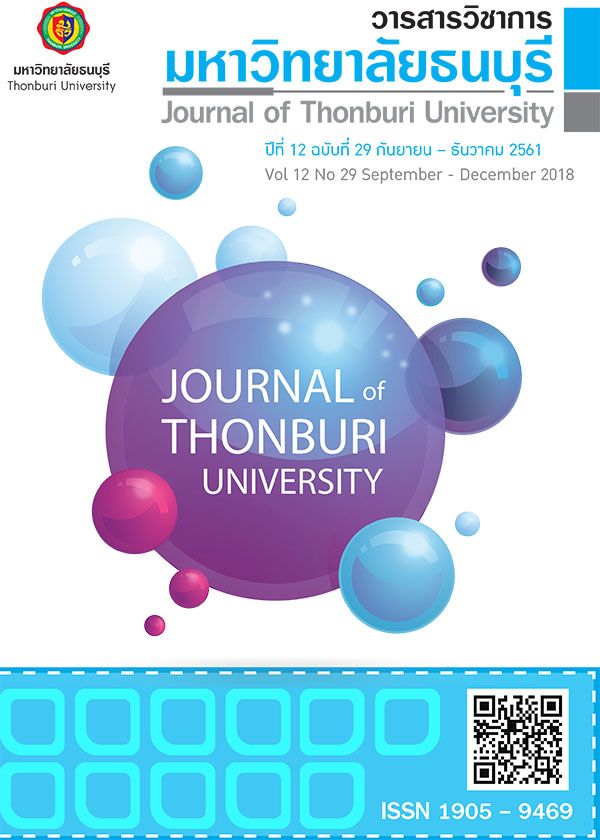EARNINGS MANAGEMENT AND SEASONED EQUITY OFFERINGS IN AN EMERGING MARKET: EVIDENCE FROM THAILAND
Keywords:
market-based accounting, earnings management, discretionary accruals, real activities manipulation, seasoned equity offeringsAbstract
Abstract
This research examines whether there was a difference of earnings management between the year of seasoned equity offerings (SEOs) and non-SEOs in Thailand during the period 2000 to 2015, and which factors drove earnings management in SEO firms. The famous Modified Jones model, and Yoon and Miller’s (2002) model (YM model) are applied to capture earnings management via discretionary accruals, whereas Roychowdhury’s (2006) model is used to measure the earnings manipulation through real activities. Based on 242 SEO firms, the results show that earnings management in the year of SEOs is significantly different from the year of non-SEOs when the models of discretionary accruals are applied. With regard to determinants, operating cash flow and time lag are two factors related to earnings management in both the discretionary accrual and real activities models, whereas the other factors (namely firm size and offer size) are relevant depending on the models applied. Nevertheless, SEOs and issuing methods show no role in driving earnings management in Thailand. Therefore, investors would be advised to put more attentions in the other factors rather than SEOs when the firms have signal of earnings management.
Keywords: market-based accounting, earnings management, discretionary accruals, real activities manipulation, seasoned equity offerings
References
Boudiche, M. (2013). Analysis of the determinants of earnings smoothing: The case of Tunisian companies. Global Journal of Management and Business Research Finance. 13(4): 16-22.
Charfeddine, L., Riahi, R., & Omri, A. (2013). The determinant of earnings management in developing countries: a study of the Tunisian context. Retrieved 5 March 2017, from https://www.researchgate.net/publication/2 56056892.
Cohen, D.A., & Zarowin, P. (2010). Accrual-based and real earnings management activities around seasoned equity offerings. Journal of Accounting and Economics. 50(1): 2-19.
Cohen, D.A., Dey, A., & Lys, T.Z. (2008). Real and accrual-based earnings management in the pre- and post-Sarbanes-Oxley periods. The Accounting Review. 83(3): 757-787.
Corwin, S. A. (2003). The determinants of underpricing for seasoned equity offers. Journal of Finance. 58(5): 2249-2279.
Dayanandan, A., & Sra, J. (2016). Determinants of earnings management in India: 2002-2011. International Journal of Accounting and Finance. 6(3): 235-254.
Dechow, P.M., Kothari, S.P., & Watts, R.L. (1998). The relation between earnings and cash flows. Journal of Accounting and Economics. 25(2): 133-168.
Dechow, P.M., Sloan, R.G., & Sweeney, A.P. (1995). Detecting earnings management. The Accounting Review. 70(2): 193-225.
Gunny, K.A. (2010). The relation between earnings management using real activities manipulation and future performance: evidence from meeting earnings benchmarks. Contemporary Accounting Research. 27(3): 855-888.
Hansen, R., & Crutchley, C. (1990). Corporate earnings and financings: an empirical analysis. Journal of Business. 63(3): 347-371.
Heron, R.A., & Lie, E. (2004). A comparison of the motivations for and the information content of different types of equity offerings. Journal of Business. 77(3): 605-632.
Intintoli, V.J., & Kahle, K.M. (2010). Seasoned equity offers: The effect of insider ownership and float. Financial Management. 39(4): 1575-1599.
Islam, M.A., Ali, R., & Ahmad, Z. (2011). Is Modified Jones model effective in detecting earnings management? Evidence from a developing economy. International Journal of Economics and Finance. 3(2): 116-125.
Jindra, J. (2000). Seasoned equity offerings, overvaluation, and timing. Working paper, Social Science Research Network.
Kunsing, P. (2013). Earnings management and performance following equity private placement. Master’s thesis, Kasetsart University.
Lerskullawat, P. (2012). Seasoned equity offerings in an emerging market; Saarbrücken, Germany: LAP Lambert Academic Publishing GmbH & Co.
Limsuthiwanpum, T., & Chaimankong, M. (2015). The relationship between compensation and earnings management: Energy and utility sector case. Journal of Thonburi University. 19(2): 146-157.
Loughran, T., & Ritter, J. R. (1995). The new issues puzzle. Journal of Finance. 50(1): 23-51.
Prangthawat, W. (2002). Earning management and the performance of seasoned equity offerings: Evidence from the stock exchange of Thailand. Master's dissertation, Chulalongkorn University.
Rangan, S. (1998). Earnings management and the performance of seasoned equity offerings. Journal of Financial Economics. 50(1): 101-122.
Rao, S.N., & Dandale, S. (2008). Earnings management: a study of equity rights issues in India. The ICFAI Journal of Applied Finance. 14(11): 20-34.
Roychowdhury, S. (2006). Earnings management through real activities manipulation. Journal of Accounting and Economics. 42(3): 335-370.
Shivakumar, L. (2000). Do firms mislead investors by overstating earnings before seasoned equity offerings? Journal of Accounting and Economics. 29(3): 339-371.
Shu, P-G., & Chiang, S-J. (2014). Firm size, timing, and earnings management of seasoned equity offerings. International Review of Economics and Finance. 29(1): 177-194.
Subramanyam, K.R. (1996). The pricing of discretionary accruals. Journal of Accounting and Economics. 22(1-3): 249-281.
Teoh, S.H., Welch, I., & Wong, T. (1998). Earnings management and the underperformance of seasoned equity offerings. Journal of Financial Economics. 50(1): 63-99.
The Stock Exchange of Thailand (2017). The structure of mai. Retrieved May 13, 2017, from https://www.set.or. th/mai/en/about/structure.html.
Tuntana, P. (2011). Earnings management by accruals of initial public offering firms in the stock exchange of Thailand. Master’s thesis, Kasetsart University
Yongtae, K., & Myung Seok, P. (2005). Pricing of seasoned equity offers and earnings management. Journal of Financial & Quantitative Analysis. 40(2): 435-463.
Yoon, S.S., & Miller, G. (2002). Earnings management of seasoned equity offering firms in Korea. The International Journal of Accounting. 37(1): 57-78.







